Chandak Sarvam Shines Bright with ‘Jewel Box on Wheels,’ Bringing Luxury to JB Nagar
Mumbai, March 24, 2025: In a city renowned for its vibrant energy and iconic landmarks, a new story is unfolding, one that isn’t just told, but experienced. Over the past few weeks, residents and visitors of Mumbai have witnessed a striking sight: a giant jewel box, mounted on a fleet of Chandak Group-branded cabs, making its way through the bustling streets. Turning heads, sparking conversations, and generating curiosity, these captivating mobile billboards have been impossible to miss, capturing the essence of luxury and refinement that defines Chandak Sarvam.
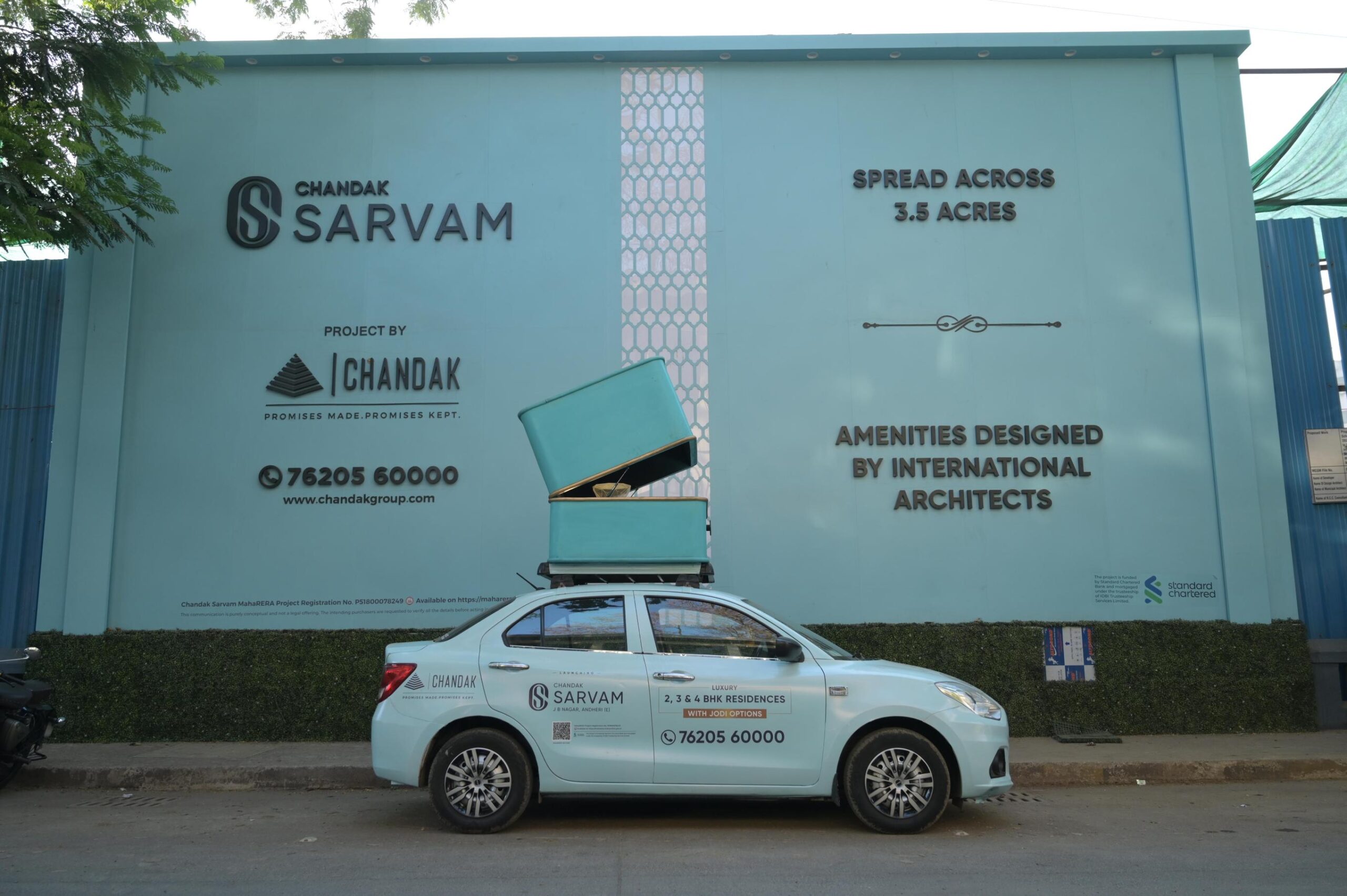
Located in the heart of JB Nagar, Andheri East, Chandak Sarvam is a newly launched residential masterpiece offering 2, 3, and 4 BHK luxury homes across 3.5 acres of meticulously designed space. More than just a residential complex, it is a symbol of the transformation of JB Nagar, designed to be as unique and exceptional as a rare jewel.Inspired by this vision, Team Chandak Group had an innovative idea: why not take the concept of a ‘jewel’ literally and create an experience that allows people to not only see but truly feel the project’s value and aspiration?
This is where BrandOnWheelz, an innovative leader in transit advertising, entered the picture with a perfect execution plan. The Jewel Box on Wheels campaign was born;a mobile, oversized jewel box, mounted atop a fleet of cabs, bringing the luxury of Chandak Sarvam directly into the streets of Mumbai. These visually stunning vehicles didn’t just act as advertisements, they became part of the city’s fabric, traveling through key locations such as offices, malls, parks, and cafes, sparking organic conversations and bringing the luxury living experience closer to potential homeowners.
“It wasn’t about selling, it was about sparking a feeling,” said a spokesperson from Chandak Group. “We wanted to engage people in a way that felt organic and non-intrusive. We aimed to make them stop, smile, take a picture, and think; ‘This could be my next home.’
The campaign was elevated further with the use of real-time location insights from Halooway/Hawkeye, which helped strategically place the cabs in high-traffic areas frequented by the target demographic. These locations, where conversations about real estate naturally occur, ensured maximum visibility and engagement with the brand.
As the Jewel Box on Wheels cabs crisscrossed the city, the buzz quickly spread. Social media feeds were flooded with images of the unique vehicles, with people sharing their experiences and the phrase “Jewel of JB Nagar” rapidly becoming more than just a tagline. It became a symbol of the area’s prestige and the luxurious lifestyle that Chandak Sarvam promises.
“This campaign was a true testament to teamwork,” said Mohammed Asghar, CEO & Co-founder of BrandOnWheelz. “When an idea as unique as this is brought to life, it takes immense dedication and effort to execute it flawlessly. I’d like to extend my deepest appreciation to every team member who played a role in bringing Chandak’s vision to fruition. It’s their hard work and commitment that turned this campaign into something truly unforgettable.”
In just a few short weeks, the Jewel Box on Wheels campaign generated over 2 million impressions, sparking widespread interest and increasing brand visibility for Chandak Sarvam far beyond the scope of traditional advertising. The campaign has not only captured the imagination of the city but has also firmly positioned Chandak Sarvam as the new symbol of luxury living in JB Nagar.
Actis Strengthens Indian Renewables Presence with Stride’s 371MW Portfolio Acquisition
24 March 2025: Actis, a leading global investor in sustainable infrastructure, has acquired a 100% stake in Stride Climate Investments (“Stride”), a solar generation asset portfolio in India, from a fund managed by Macquarie Asset Management.
The deal sees Actis take charge of Stride’s 371MW (414MWp) portfolio of operating solar PV assets spread across 21 projects in 7 states, the majority of which are concentrated in the state of Gujarat. The Stride portfolio, which has close to a decade of demonstrated track record, features long-term pay-as-produce power purchase agreements with a diversified pool of off-takers, from central and state governments as well as the private sector, and a distributed asset base.
Actis has deployed more than US$7.1 billion in Asia since inception across different strategies and, as a leading energy investor, has built or operated more than 8GW of installed capacity in the region, including more than 5.5GW of renewables.
With this acquisition, Stride joins BluPine Energy and Athena Renewables to become Actis’ third current energy generation platform in India.
Adrian Mucalov, Partner, Head of Long Life Infrastructure at Actis, said: “The acquisition of Stride aligns nicely with Actis’ long life infrastructure investment approach. The business has a 10-year operating history, compelling cash generation and low existing leverage. We believe Stride offers strong prospects to deliver cash yields to investors while also being in a dynamic, rapidly growing market.”
Abhishek Bansal, Partner, Energy Infrastructure at Actis, commented: “Actis has a long experience of successful investment in the Indian renewable energy sector, exemplified by Ostro Energy and Sprng Energy previously as well as by our current renewables platforms. The Indian economy is continuing to grow rapidly and its energy transition is accelerating apace, with the government aiming to secure 50 percent of the country’s electricity from renewables by 2030. This environment is therefore creating ample opportunities, especially for an investor such as Actis with expertise in driving efficiency and creating value in this market.”
L&T Energy Green Tech Joins Forces with John Cockerill Energy for Cutting-Edge Green Solutions
Mumbai, March 24, 2025: L&T Energy Green Tech Limited (LTEGL) and John Cockerill signed a Memorandum of Understanding (MoU) to explore various technologies in Concentrated Solar Power (CSP) and Thermal Energy Storage (TES).
LTEGL, a wholly owned subsidiary of L&T, is dedicated to sustainable energy solutions, including Green Hydrogen, its derivatives, and Electrolyser Manufacturing. Centered on its three core business pillars — Development, Manufacturing, and EPC — LTEGL offers integrated solutions across the Green Energy value chain through advanced technology, strategic partnerships and dedicated R&D.
With the strength of more than 200 years of experience in energy and industry, John Cockerill is developing innovative technological solutions which contribute to the energy transition, whether by developing new electricity production capacities from renewable sources, storing green electricity or optimising the electricity output of electric power plants and industrial installations. The Group adapts its technologies and expertise — heat recovery steam generators, receivers for concentrated solar power plants, integrated units for the production, storage and management of green electricity, industrial boilers, Hamon cooling systems — to the specific needs of its clients in the industrial and energy domains.
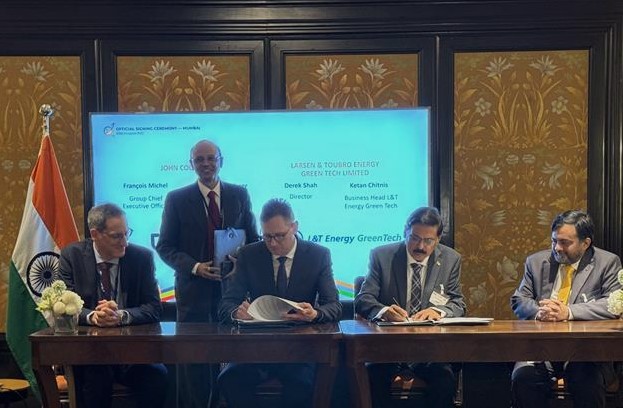
The MoU aims to identify and develop strategic collaboration opportunities in manufacturing, component supply and engineering solutions critical to the successful implementation and deployment of CSP and TES projects.
Commenting on the occasion, Mr Subramanian Sarma – Whole-time Director & President (Energy), L&T said, “L&T remains committed to accelerating the adoption of next-generation green energy technologies. Ensuring round-the-clock availability of renewable power is crucial for driving the global energy transition. Our collaboration with John Cockerill marks a significant step in this direction, combining L&T’s end-to-end expertise in manufacturing, EPC and services with John Cockerill’s global leadership in energy.”
Mr. Thomas Bohner, CEO of John Cockerill Energy commented, “We are extremely happy to partner with LTEGL in exploring and leveraging opportunities to make India’s manufacturing sector sustainable and efficient. Our CSP and TES technologies are leading the way for renewable and dispatchable power and heat projects, from small to large scale, on and off-grid, on a worldwide basis. With our expertise and references, including 5 state-of-the-art solar thermal receivers for concentrating solar power plants in the United Arab Emirates, China, Chile and South Africa, we are confident that this partnership with LTEGL will enable us to deliver these offerings to companies in India that are actively pursuing low carbon energy solutions.”
“Partnering with John Cockerill and leveraging its expertise in CSP and TES technology allows us to integrate advanced energy storage solutions with our robust engineering and manufacturing capabilities. By leveraging these synergies, we aim to accelerate the deployment of green RTC power generation, driving the shift towards a greener, more sustainable energy future” underscored Mr Derek Shah, Sr Vice President & Head, L&T Energy – Green Mfg. & Development.
Mr Vivek Bhide, Regional President and Group Transformation Officer, John Cockerill added, “Indian businesses are increasingly partnering with the government in supporting its move towards sustainable energy adoption and net zero commitments. Our CSP and TES technology will aid this transition and deliver reliable and sustainable energy solutions to Indian businesses. We are grateful for LTEGL’s partnership and look forward to collaborating with them in bringing this world-class technology to India.”
CleanTech Business Club Partners with Advait Energy to Drive Sustainable Energy Innovations

March 24,2024:Advait Energy Transitions Ltd. (AETL), a leading force in the energy sector, has joined forces with the CleanTech Business Club (CBC) and its strategic ventures – Go For Hydrogen Africa (GFHA) and Cleanvestree Africa – to spearhead global initiatives in CleanTech, power transmission, and carbon market integration. These landmark collaborations mark a transformative step in advancing clean energy solutions, strengthening global industries, and accelerating Africa’s clean economy.
Advait and CBC Unite to Establish the CBC Carbon Exchange Hub
AETL and CBC have formed a pioneering initiative to converge CleanTech industries, carbon markets, and power transmission. As part of this collaboration, Advait will take the lead in structuring the CBC Carbon Exchange Hub, an innovative platform that integrates carbon credits into cleantech, clean water, and clean hydrogen solutions.
Key Highlights of the Partnership:
- Global Headquarters in Ahmedabad – Advait will host the CBC Carbon Exchange Hub’s global office in India, ensuring a robust operational base.
- Leadership Appointments – Shalin Sheth, Founder and MD of Advait, will serve as Chair of the CBC Carbon Exchange Hub, while Avantika Gupta, Head of Carbon Markets at Advait, will be Co-Chair, overseeing global operations.
- Revolutionizing Carbon Credit Utilization – The initiative will set a new benchmark in carbon market adoption, offering industries an innovative mechanism to monetize sustainability initiatives.
Advait to Lead Power Transmission and Renewable Energy Integration for CBC
Acknowledging the urgent need for resilient power infrastructure, Advait and CBC have embarked on a long-term alliance to advance power transmission solutions, supporting high-renewable energy systems worldwide.
Key Aspects of this Partnership:
- Industry Leadership & Knowledge Sharing – Advait will guide CBC’s leadership in building a sustainable power transmission ecosystem integrating renewables, hydrogen utilization, and smart energy solutions.
- Strategic Integration Across CBC Hubs – Advait will work closely with CBC’s Energy Majors, Mining & Utilities Hub, aligning best practices in CleanTech, Clean Hydrogen, and Clean Water.
- Expansion of CleanTech Offerings – Cleanvestree, CBC’s business arm, will assist Advait in identifying global partners to enhance its technology and solutions portfolio.
Advait’s Role in Transforming CleanTech in Africa
AETL, along with Cleanvestree, Cleanvestree Africa, and GFHA, has also entered into a strategic partnership to advance CleanTech, clean hydrogen, and clean water transformation in Morocco and across Africa. This initiative aims to integrate resilient power transmission solutions and carbon trade markets into Africa’s economic growth strategy, fostering sustainable development and energy security.
Key Deliverables of the Partnership:
- Integration into CBC’s #TogetherWeAreStronger Ecosystem – Advait will provide power transmission solutions and EPC services for CleanTech, hydrogen, and ammonia projects in Morocco and across Africa.
- Market Expansion Across 17 African Countries – Cleanvestree Africa will represent Advait, ensuring regional market penetration and business expansion.
- Showcasing Technological Excellence – Advait will provide product samples and live demonstrations of its Energy Restoration System, showcasing its innovation to government officials and industry stakeholders.
- Vision for a CleanTech Manufacturing Hub in Morocco – Advait will collaborate with GFHA and CBC Consortium partners to establish a state-of-the-art manufacturing hub for CleanTech and clean hydrogen solutions in Africa.
Industry Leaders Speak on the Strategic Collaboration
Tomasz Slusarz, Founder and Vision Streamliner at CleanTech Business Club, emphasized the significance of this collaboration, stating: “These partnerships highlight CBC’s core principle of collaboration over competition. With Advait’s expertise in energy transition solutions, we are setting new standards for CleanTech and carbon market integration globally.”
Shalin Sheth, CEO of Advait Energy Transitions, expressed his enthusiasm for the new alliances: “These partnerships mark a crucial milestone in our mission to transform the global energy landscape. Through our collaboration with CBC and its ecosystem, we are reinforcing our commitment to sustainability, innovation, and global CleanTech leadership.”
A Unified Vision for a Sustainable Future
As the world grapples with urgent climate and energy challenges, this collaboration between Advait Energy Transitions, CBC, Cleanvestree, GFHA, and Cleanvestree Africa sets a strong foundation for a cleaner and more resilient future. With a shared vision of sustainability and innovation, these alliances aim to redefine CleanTech adoption, integrate carbon markets, and expand power transmission solutions across key global and African markets.
SonicWall Partner Focus Secures Strong Business Momentum in Transformational Year
Bangalore March 24, 2025 — SonicWall today announced continued business momentum powered by its relentless focus on partners, strategic partnerships and innovation across its portfolio. In addition to the company’s focus on Managed Service Providers (MSPs) and Managed Security Services Providers (MSSPs), SonicWall is experiencing unprecedented growth in its Zero Trust Network Access (ZTNA) and other Cloud Secure Edge Solutions as further evidence that SonicWall is quickly becoming a market leader in the broader cybersecurity SMB space.
While maintaining its market dominance in firewalls and network security appliances for the small to midsized market, SonicWall is quickly transforming its ecosystem of over 17,000 partners globally to offer cloud native solutions and co-managed security solutions including Managed XDR backed by the SonicSentry team of 24×7 cybersecurity professionals.
“SonicWall’s inside-out approach, kicked off almost 3 years ago, has uniquely positioned us to anticipate and meet the evolving needs of our partners and customers more effectively than ever,” said SonicWall CEO and President, Bob VanKirk. “By listening and acting on partner feedback, expanding our world-class cybersecurity offerings, and bringing to market solutions designed specifically for MSPs we are ensuring that our partners have the support they need to thrive, and empower them to keep their customers safe. Together, we are not just keeping pace with industry demands; we are setting the standard for success in cybersecurity.”
Financial Growth and Partner Expansion
SonicWall’s most recent financial results demonstrate strong growth, fuelled by new customer acquisitions and the success of its partner initiatives:
- Managed Security Services (MSS) Bookings: Drove a 68% year-over-year increase.
- Zero Trust / Cloud Secure Edge (CSE) Bookings: Grew 70% year-over-year, with transacting partners climbing almost 40% quarter-over-quarter.
- Service Provider Program Growth: Generated a 91% increase in partners, underscoring the high demand for SonicWall’s MSP/MSSP solutions.
- Partner Growth: Four consecutive quarters of year-over-year growth in transacting partners, displaying the active momentum of SonicWall’s channel-first strategy.
Debasish Mukherjee, Vice President of Sales, APJ at SonicWall, said, ‘SonicWall’s growth in APJ is a testament to our commitment to delivering innovative, scalable cybersecurity solutions that empower our partners. By equipping MSSPs and MSPs with advanced threat protection, cloud-native security, and flexible service models, we enable them to safeguard businesses of all sizes while driving long-term success. As cyber threats evolve, our focus remains on providing the right tools, intelligence, and support to help our partners stay ahead, ensuring they can meet the security needs of their customers with confidence and efficiency.’”
Going “Beyond the Wall”
“Last year was pivotal for SonicWall as we capitalized on the acquisitions we made in 2023 and integrated them into our portfolio, our platform and our most valuable asset – our partner ecosystem,” said SonicWall Chief Strategy Officer, Matt Neiderman. “As we have expanded our offerings to include key capabilities like ZTNA and MXDR, our focus has been on designing them and bringing them to market in a way that supports the needs of the MSP and broader partner community. Now more than ever, we have a more complete set of tools that partners of every size can leverage to protect their customers and compete in an evolving IT services market.”
SonicWall’s expanded offerings have strengthened its cybersecurity portfolio and market position, helping to enable its partners to protect their customers across the threat landscape. These additions have enabled the company to introduce flexible, subscription-based pricing tailored to MSPs, enhance managed security services for more comprehensive protection (i.e., protecting the protectors), and advance zero trust /cloud security solutions that support businesses in their digital transformation.
With a strong foundation built on financial growth, partner expansion, and broad cybersecurity portfolio, SonicWall is poised for continued success in the coming year. The company remains committed to:
- Enhancing its cybersecurity portfolio with next-generation security solutions, delivering powerful capabilities through an intuitive, cloud-native platform designed for ease of use.
- Expanding its partner community, equipping MSSPs and MSPs with the tools and platform needed to thrive in a rapidly evolving threat landscape.
- Driving continued innovation to address evolving threats and market demands, ensuring seamless, scalable protection with a focus on simplicity and efficiency.
By aligning its offerings with partner needs, SonicWall continues to build momentum, demonstrating its ability not just to adapt but to lead in the cybersecurity landscape. SonicWall continues to set new benchmarks for success in cybersecurity.
Celebrations Begin as Mars Wrigley India Introduces SNICKERS® Peanut Brownie – The Ultimate Treat
National, 24th March 2025 – SNICKERS®, the iconic chocolate brand from Mars Wrigley India, has always been the go-to hunger bar that sorts you out when you’re not yourself. Now, it’s taking hunger satisfaction to a whole new level with the launch of its indulgent innovation: the all-new SNICKERS® Peanut Brownie. Packed with the rich, decadent flavors of a brownie and the classic SNICKERS® experience of gooey caramel, crunchy peanuts, and smooth chocolate, this new variant is here to save you when hunger hits. And true to its legacy, SNICKERS® has rolled out a fresh, hilarious TVC that brings its hunger-satisfaction promise to life in the quirkiest way possible.

Loved for its global legacy ads that bring alive hunger transformation, Snickers India famous for its ads starring celebrities like Rekha, Sonam Kapoor, MS Dhoni, and Rohit Shetty has once again dropped a rib-tickling film. This time, SNICKERS® Peanut Brownie steps in as the ultimate hunger hero, blending humor with the brand’s signature promise of satisfaction. The TVC captures the chaos of hunger in a relatable yet wildly entertaining way, reminding everyone why SNICKERS® is the ultimate hunger fix.
Set in a bustling office, conceptualised by DDB Mudra the TVC playfully highlights the madness that ensues when hunger strikes. Through a quirky narrative, it shows how the SNICKERS® Peanut Brownie comes to the rescue. Based on the insight that when hunger kicks in, one tends to eat just about anything; SNICKERS® Peanut Brownie reinforces the message, “Bhook mein kuch bhi mat kha. Kuch tasty kha.” (“Don’t eat just anything when you’re hungry. Eat something tasty.”). The ad wraps up with the iconic brand tagline, “You’re not you when you’re Hungry!”, driving home the message that SNICKERS® is the ultimate solution for hunger-induced chaos.
“SNICKERS has always been the OG hunger satisfier, and with the Peanut Brownie, we’re elevating that experience to a whole new level. This launch is not just about delighting our loyal consumers but also inviting more chocolate lovers to join the SNICKERS family. By bringing a taste from our global pantry to India, we’re staying true to our promise of delivering the tastiest hunger fix. After all, ‘You’re not you when you’re hungry,’ and the SNICKERS Peanut Brownie ensures you stay yourself in the most delicious way possible.” said Himanshu Gupta, Strategic Demand Manager, Mars Wrigley India.
Brand Snickers has the juiciest communication platform of ‘You’re not you when you’re hungry’. And this ad takes it forward by, for the first time, showing the transformation of us when we’re hungry into an inanimate object. The insight is simple – when hunger strikes, we rummage, hunt and search out whatever that’s edible, and stuff our mouth with it, quite like a vacuum cleaner. Luckily, we won’t have to resort to such desperate measures anymore, because the tastiest hunger fix is here – Snickers Peanut Brownie. All through this project, making a vacuum cleaner play the lead role has been both a challenge and a joy for us all, said Iraj Fraz, Creative Head, DDB Tribal
Lenzing Conclave Drives Digitization & Sustainability in Knitted & Woven Textile Production
Ludhiana, India, March 24, 2025 – The Lenzing Group, a global leader in wood-based specialty fibers, successfully hosted the Lenzing Conclave at Radisson Blu Hotel in Ludhiana, bringing together key players from the textile industry, including manufacturers, exporters, dealers, agents, and leading brands. This exclusive event served as a dynamic platform to explore Lenzing’s latest fiber innovations and their diverse applications in knitted and woven textiles.
As part of its ongoing commitment to sustainability and innovation, Lenzing showcased its cutting-edge fiber portfolio, featuring TENCEL™ Lyocell A100, LF, x Micro, Fill, and LENZING™ ECOVERO™ Black with a special focus on innerwear, sleepwear, athletic/activewear, lingerie, and ethnic wear, the conclave provided valuable insights into the evolving demands of the textile industry. By engaging with manufacturers, exporters, and brands, Lenzing reaffirmed its commitment to delivering holistic solutions. The conclave provided insights into evolving industry demands while reaffirming Lenzing’s commitment to fiber innovation, technical and marketing support, and supply chain solutions for a more sustainable textile future.
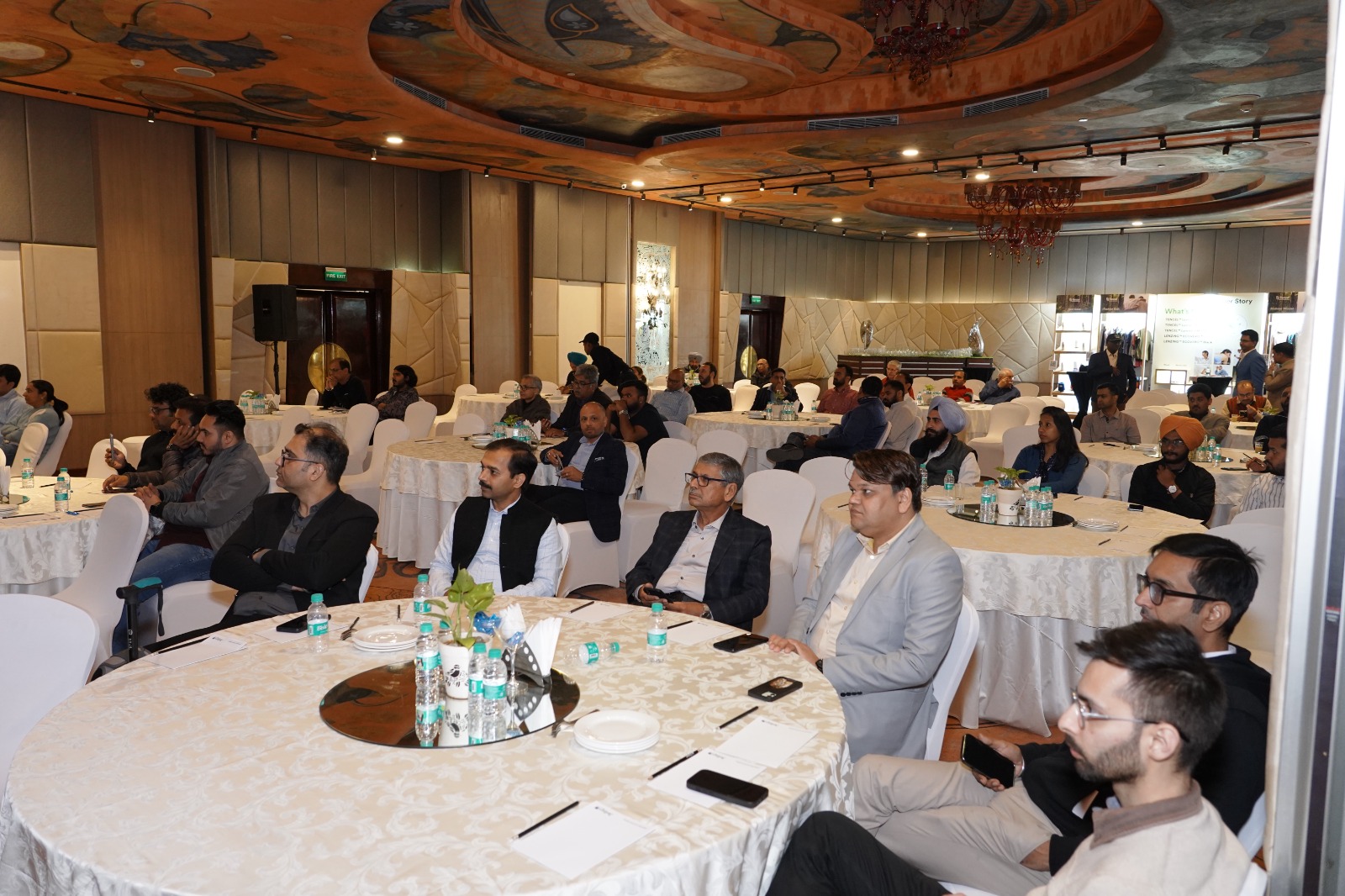
Avinash Mane, Senior Commercial Director for AMEA & NEA in Commercial Textiles at Lenzing Group, emphasized the company’s vision, stating: “As the demand for eco-conscious textiles continues to grow, Lenzing remains at the forefront of innovation, empowering brands and manufacturers with high-performance fibers that prioritize both quality and sustainability. Our TENCEL™ and LENZING™ ECOVERO™ fibers represent the future of textile production, offering versatility across multiple categories while significantly reducing environmental impact. The Lenzing Conclave in Ludhiana served as a crucial platform to foster collaboration and drive meaningful change in the industry.”
Through interactive discussions and product showcases, the Lenzing Conclave in Ludhiana successfully strengthened industry connections and reinforced Lenzing’s position as a global leader in sustainable fiber solutions. The Lenzing Group extends its gratitude to all attendees for their enthusiastic participation and looks forward to fostering future partnerships that will shape a more sustainable future for the textile industry
Vivek Technotronix 24-25″ at VES Polytechnic Welcomes Future-Ready Tech Enthusiasts
March 24, 2025 – VES Polytechnic successfully concluded its two-day project exhibition, “Vivek Technotronix 24-25,” held on March 21st and 22nd, 2025. The event showcased the ingenuity of 109 student groups from diverse engineering disciplines, including Automation and Robotics, Computer Engineering, Electronics and Telecommunication, Mechanical Engineering, Civil Engineering, and Electrical Engineering. Students presented a wide array of innovative projects focusing on emerging technologies, with many aligned with the United Nations’ 17 Sustainable Development Goals (SDGs), demonstrating a commitment to addressing global challenges. The exhibition highlighted the institution’s dedication to fostering practical learning and innovation among its students.
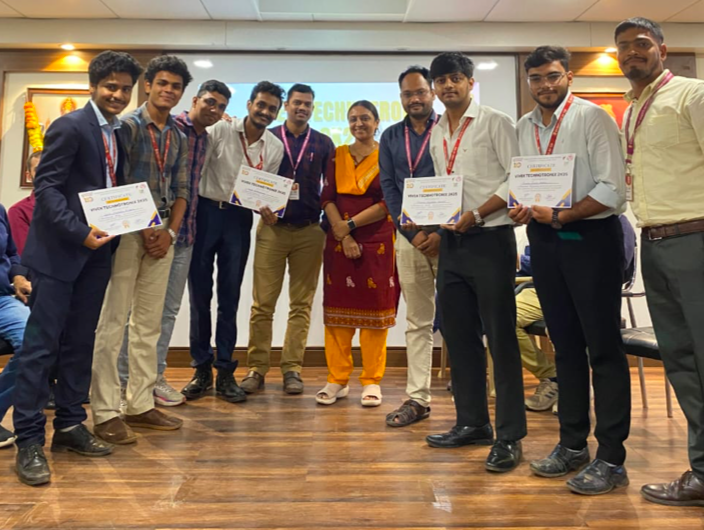
The evaluation process was conducted by esteemed judges from academia and industry, ensuring a rigorous assessment of the projects. Winners were selected from each discipline, demonstrating exceptional innovation and technical skill. In Automation and Robotics, the winning project was Solar Panel Inspection and Cleaning Drone, while in Computer Engineering, Audio to Sign Language and Vice Versa Converter (SIH) took the top spot. Other winning projects included SOC Designing for Robotic Application in Electronics and Telecommunication, Sustainable Pad Recycling in Mechanical Engineering, and Cell-Filled Concrete Pavement in Civil Engineering. The diverse range of projects underscored the students’ ability to apply theoretical knowledge to practical, real-world solutions.
“We are incredibly proud of the hard work and dedication displayed by our students,” said Vikrant Joshi, Principal, VES Polytechnic . “The projects showcased at Vivek Technotronix 24-25 demonstrate their ability to innovate and address critical challenges using cutting-edge technologies. This event reinforces our commitment to providing a platform for students to explore and develop their skills.”
Vivek Technotronix 24-25 served as a platform for students to demonstrate their technical prowess and innovative thinking, aligning with the institution’s mission to produce skilled engineers capable of contributing to society. The event’s success highlights VES Polytechnic’s commitment to nurturing future leaders in engineering and technology. The judges, including Mr. Uday Bhausaheb Shinde, Dr. Manoj Patil, Dr. Surendra Singh Rathod, Mr. Jitesh G. Bhagat, Mrs. Sanika Jaygade, and Mrs. Jothi Jagaldas, among others, provided valuable feedback and expertise, contributing to the event’s success.
NIIT Limited Expands Opportunities with gNIIT – A Customizable Program for Undergraduate Success
New Delhi, 24th March 2025: NIIT Limited, India’s leading skills and talent development corporation, has announced that it will now offer gNIIT as customizable dual qualification program for undergraduate (UG) students. The program equips learners with industry-relevant skills, exposure to digital technologies, and practical experience to enhance their career prospects. This significantly improves their chances of employment by the time they graduate, saving their most precious time, and ensuring they are real-world ready by the time they graduate.
The gNIIT program is designed for UG students who often have limited job opportunities after graduation. The design of the program helps students explore digital tools, acquire essential skills, and choose from different specialization tracks that match their interests. This ensures they are equipped with the skills required by most employers and the market. The program’s structure is divided into distinct “stacks” or stages, with each stack consisting of a series of courses that build expertise in specific domains. These include the Digital Proficiency Stack, Digital Mastery Stack, Role Specialization Stacks, and Industry Experience Stack.
Backed by research and built for the future, gNIIT was designed to align with industry needs. The curriculum has been developed after an extensive study of over 10 market reports and insights from more than 300 job roles (from leading employers in technology, banking, finance, marketing, manufacturing, and education). It has also been benchmarked against more than 20 corporate training programs, and analysis of over 4,000 interview questions. Additionally, direct feedback from over 1,000 students across disciplines helped shape the curriculum that meets real-world demands. A six-month industry internship further provides students with hands-on experience, making them workplace ready.
Vijay K Thadani, Vice Chairman & Managing Director, NIIT Limited, said, “The gNIIT program is meant for a vast population of Indian UG students who will now have the opportunity to utilize their 3 or 4 years of graduation – earn dual qualification, acquire digital skills and real-world experience via internships – making them employable. While traditional degrees provide strong foundational knowledge, many graduates lack the essential digital skills they need to survive in the rapidly evolving digital world. Designed for both tech and non-tech students, gNIIT bridges the skills gap to make learners real world ready. Backed by research and built for the future, it integrates digital skills, real-world projects, and industry internships to prepare students for evolving careers.”
Pankaj Jathar, Chief Executive Officer, NIIT Limited, expressed his views on the announcement of the program, “NIIT has always been at the forefront of introducing future-ready solutions and the all new gNIIT program, with the skill-driven, digitally focused framework is designed to propel students towards thriving careers in the digital age. We provide a well-rounded curriculum that includes various digital technologies. Our hands-on courses, mentor-led delivery, and capstone projects prepare learners for real-world challenges. Plus, a six-month industry internship ensures they are truly ready for the job market.”
Empowering Education One Step at a Time: Sunstone’s Hi-5 Initiative in Action
Gurugram, March 24, 2025 – In a spectacular display of corporate wellness innovation, Sunstone, a leading higher education company of India, transformed the traditional marathon experience into a powerful engine for social change at Tuffman Marathon in Gurugram!
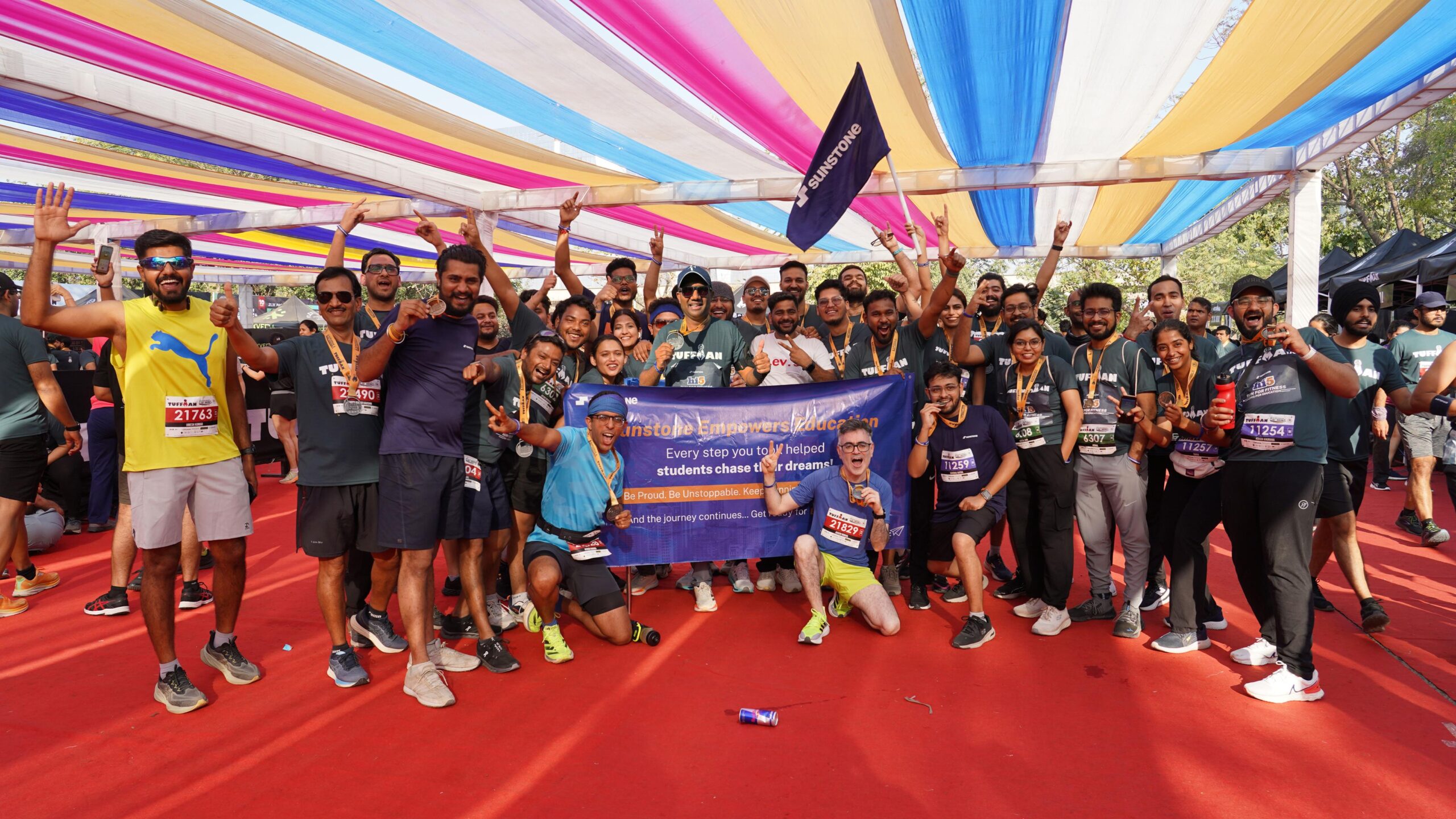
The education powerhouse unveiled its impactful “Hi5 for Education, Fit@Sunstone” initiative, creating a first-of-its-kind connection between physical fitness and educational empowerment. For every Hi5 exchanged with Sunstone participants during the race, a direct contribution flowed to NGO SEF’s educational programs — turning sweat equity into learning opportunities!
An electrifying contingent of 35 Sunstone champions conquered the course, collectively logging an impressive 500+ kilometers while generating over 3,500 high-fives! This extraordinary effort didn’t just showcase physical prowess — it demonstrated how companies can reimagine corporate wellness programs to simultaneously boost employee health, workplace morale, and community impact.
This interesting initiative has dramatically boosted workplace spirit and productivity while powering SEF’s crucial educational mission, cementing Sunstone’s position as a pioneer in combining employee wellbeing with meaningful social impact.
The Marathon represents our philosophy that meaningful impact requires both personal excellence and collective purpose,” declared Mr. Ashish Munjal, CEO and Co-Founder of Sunstone. “Through this initiative, we’ve proven that corporate wellness programs can transcend traditional boundaries to create ripple effects of positive change. Our employees demonstrated incredible spirit and we are committed to fostering a culture of well-being and social impact.”
The event also resonated deeply with NGO SEF. Mainak Roy, Co-Founder and CEO of SEF, said, “Education is a powerful tool for change, and initiatives like this bring communities together for a greater cause. Sunstone’s support through the marathon has been invaluable in helping us reach more students and provide them with the resources they need. We appreciate their efforts in making fitness a force for good.”
This initiative sets a new benchmark for forward-thinking organizations aiming to enhance wellness programs while making a social impact—taking one step closer to education, fostering healthier employees, empowered communities, and a more purpose-driven workplace culture.
